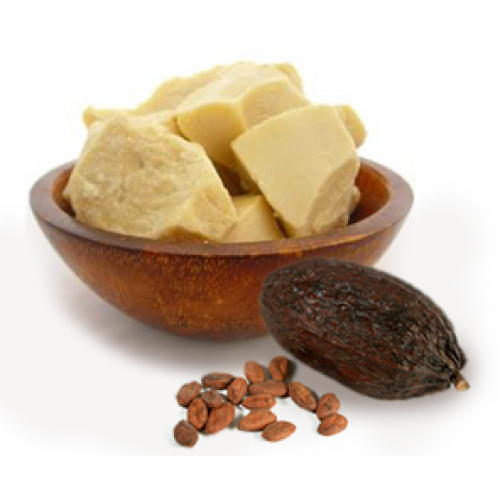Raw Cacao Butter
Cocoa butter is a triglyceride — a type of fat that’s naturally found in cocoa beans and other sources. It is the edible fat that’s extracted from cocao beans. In fact, around 55% of the bean’s weight is from the cacao butter.
It’s pale yellow in colour. Despite the word ‘butter,’ in the name, this fat is entirely vegan and plant-based, stemming only from the cacao bean.
It has the amazing trait of melting just below human body temperature (34–38 °C) (93–101 °F). This is why chocolate is solid at room temperature and melts perfectly in our mouth.
It is also a common ingredient in cosmetic products because of its moisturizing properties. It is naturally rich in nutrients and antioxidants and is a stable fat that doesn’t go rancid easily, giving it a shelf life of three to five years.
HOW IS CACAO BUTTER MADE?
Cacao butter is made from cocoa beans, which are the seeds of the Theobroma cacao tree. Butter isn’t pressed from the raw beans, instead, they are first fermented, dried, roasted and cracked to create cacao nibs. These nibs are then ground into a thick paste known as cocoa liquor. The nibs and cocoa liquor are pressed, which separates the solid content from the fat (the cacao butter). The solid content goes on to become cocoa powder.
DEODORISED VS. nON-DEODORISED
Not all cacao butter is the same. There are generally two types: deodorized and non-deodorized. Let’s take a look at some of the advantages and disadvantages of both.
DEODORISED
Deodorized cacao butter has been treated either chemically or physically to reduce the natural odours. The most common method is where the butter is injected with high-heat steam. The outcome is a neutral flavour and light colour.
Deodorized cacao butter is commonly used for cosmetics as it doesn’t contain the strong cocoa aromas. It is also occasionally added by chocolatiers or chocolate makers to recipes when they don’t want a strong cocoa flavour and aroma to interfere with the other flavours they have used.
The downside of deodorising it is that the treatment of deodorising strips it of its highly beneficial natural nutrients and antioxidants. The vast majority of white chocolate you find in the shops is made with deodorised cacao butter. Because it’s been stripped of its aromas, the makers add vanilla and a lot of sugar.
This is why white chocolate often has a bad reputation for being overly sweet.
NON DEODORISED
Non-deodorised (or un-deodorised) cacao butter is unrefined and natural. Unlike its deodorised counterpart, it retains its pale-yellow colour and strong cacao flavour and aroma.
The benefit of non-deodorised is the creation of delicious single-origin white chocolate. Instead of relying on vanilla, the non-deodorised variety has enough flavour to create delicious white chocolate.
Moreover, non-deodorised cacao contains much more of the vital antioxidants present in cacao, making it the healthier choice.
The downside of using non-deodorised cacao butter is that its strong flavour might interfere with other flavours.
HEALTH BENEFITS:
Cacao butter is very healthy for the human body if consumed in moderation. It’s considered a heart-healthy fat as it’s high in monounsaturated and polyunsaturated fats. Healthy fats not only support your brain health, but they also boost your mood and can even help lower blood cholesterol levels.
It’s also a good source of magnesium, iron and Vitamin E. Moreover, cocoa butter is packed with powerful antioxidants flavanols. Antioxidants help lower inflammation in the body and support the immune system.

